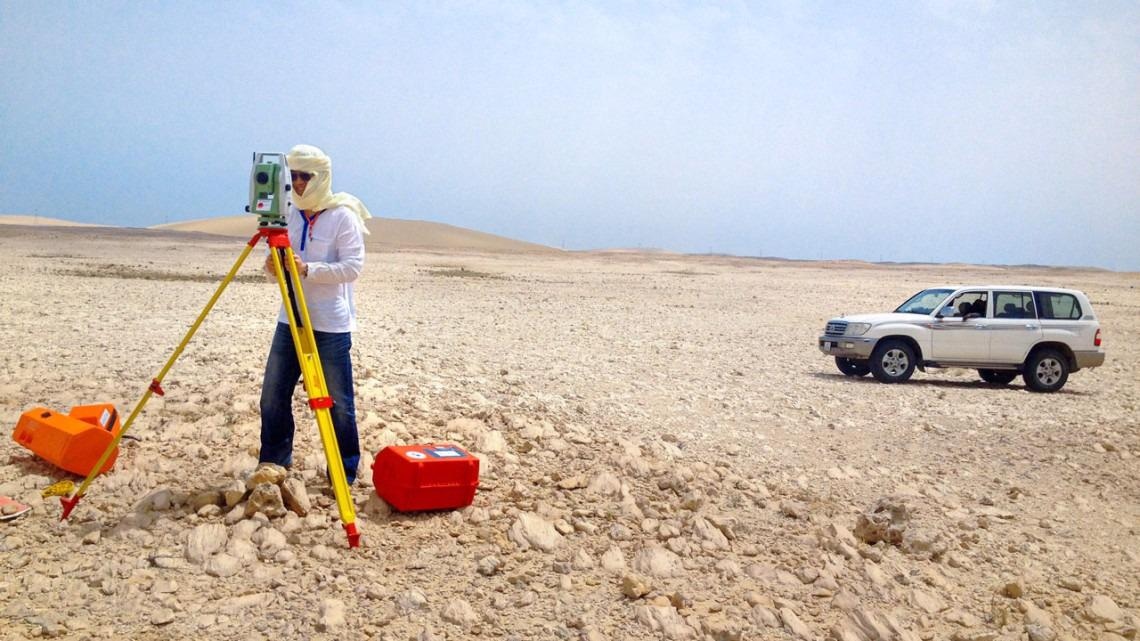Deserts might appear to be inactive and lifeless, but they are actually very much alive. Sand dunes, in particular, tend to grow and move from one place to another — and as per the decades-long research project performed, they also breathe humid air.
 Jin Xu, Ph.D.’ 14, surveys sand dunes. Image Credit: Cornell University.
Jin Xu, Ph.D.’ 14, surveys sand dunes. Image Credit: Cornell University.
For the first time, the findings illustrate how water vapor pierces grains and powders and could have broad-ranging applications far beyond the desert, in agriculture and food processing, pharmaceutical research, as well as planetary exploration.
The team’s paper was published in the Journal of Geophysical Research-Earth Surface on March 21st, 2022.
Under the guidance of Michel Louge, lead author of the study, and professor of mechanical and aerospace engineering in the College of Engineering, the project has spanned a great deal of time and a range of terrain. It started nearly four decades ago when Louge was learning about the behavior of gasses, fluids and solid particles.
Louge wished to quantify matter with higher sensitivity, he and his students designed a new form of instrumentation known as capacitance probes, which utilize several sensors to record everything right from solid concentration to velocity to water content. All this can be done with unparalleled spatial resolution.
At the University of Utah, a technology was suggested by Louge’s colleague that may be beneficial in imaging the layers of mountain snowpacks and evaluating the probability of avalanches.
Then, Louge went to his garage, grabbed some probes, and tested them out at a snowstorm. He soon struck up a collaboration with a company, named Capacitec Inc, to integrate their respective skills in electronics and geometry. Also, the consecutive probes proved beneficial in hydrology research.
At the beginning of the 2000s, Louge started collaborating with Ahmed Ould el-Moctar from the University of Nantes, France, to utilize the probes to study the moisture content present in sand dunes to better comprehend the process by which agricultural land gets converted into a desert - an interest that has become even more pressing with the increase in global climate change.
Louge stated, “The future of the Earth, if we continue this way, is a desert.”
While other probes can quantify huge volumes of matter, Louge’s probes go deep and small, gathering data on a millimetric scale to spot the correct amount of moisture and the density of sand present.
Certain alteration is required for probes to function in a new environment. As a result, this decade-long process of trial and error began, and Louge began making periodic travels to deserts in Mauritania and Qatar thereby experimenting with various versions probe.
Ultimately, the probe disclosed just how porous sand is, consisting of a small amount of air seeping across it. The early study had suggested this kind of seepage was present in sand dunes, but no one, up until now, was able to prove it.
The wind flows over the dune and as a result creates imbalances in the local pressure, which literally forces air to go into the sand and out of the sand. So the sand is breathing, like an organism breathes.
Michel Louge, Professor, Mechanical and Aerospace Engineering, Cornell University
Despite the high temperature, the so-called “breathing” is what enables microbes to remain deep inside hyper-arid sand dunes. For most of the past decade, Louge has been uniting with Anthony Hay, associate professor of microbiology in the College of Agriculture and Life Sciences, to gain better insights into how microbes can help stabilize the dunes and stop them from invading roads and infrastructure.
Furthermore, Louge and his group identified that desert surfaces tend to exchange less moisture with the air compared to what is anticipated, and that water evaporation coming from individual sand grains acts as a slow chemical reaction.
The majority of their data was collected in 2011, but even then it took another 10 years for Louge and his collaborators to make sense of their findings, like determining disturbances at the surface level that drive evanescent, or nonlinear, waves of humidity to circulate downward via the dunes so rapidly.
We could have published the data 10 years ago to report the accuracy of our approach. But it wasn’t satisfying until we understood what was going on. Nobody really had done anything like this before. This is the first time that such low levels of humidity could be measured.
Michel Louge, Professor, Mechanical and Aerospace Engineering, Cornell University
The scientists predict that their probe will hold numerous applications — from studying the way soils absorb or drain water in agriculture, to calibrating satellite observations over deserts, to examining extraterrestrial surroundings that might hold small amounts of water. That would not be the first time that Louge’s research made its way into space.
However, probably the most immediate application considered is the detection of moisture contamination present in pharmaceuticals. Since 2018, Louge has been uniting with Merck to make use of the probes in constant manufacturing. This has been viewed as a quicker, highly efficient and budget-friendly system compared to batch manufacturing.
If you want to do continuous manufacturing, you have to have probes that will allow you, as a function of time, and everywhere that’s important, to check that you have the right behavior of your process.
Michel Louge, Professor, Mechanical and Aerospace Engineering, Cornell University
The co-authors of the study include Ould el-Moctar; Jin Xu, Ph.D.’ 14; and Alexandre Valance and Patrick Chasle with the University of Rennes, France.
The study was financially supported by the Qatar Foundation.
Journal Reference:
Louge, M. Y., et al. (2022) Water vapor transport across an arid sand surface - non-linear thermal coupling, wind-driven pore advection, subsurface waves, and exchange with the atmospheric boundary layer. JGR Earth Surface. doi.org/10.1029/2021JF006490.